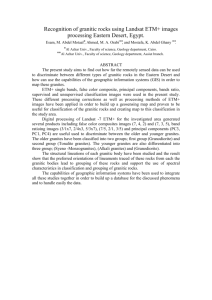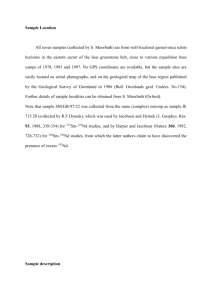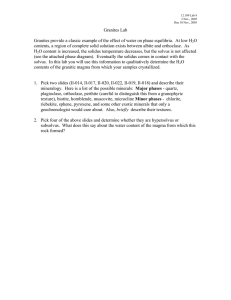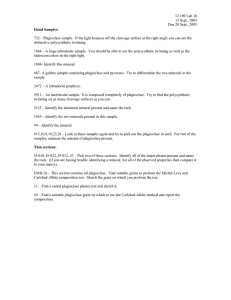14. MYRMEKITE IN MUSCOVITE-GARNET GRANITES IN THE MOJAVE DESERT, CALIFORNIA
advertisement
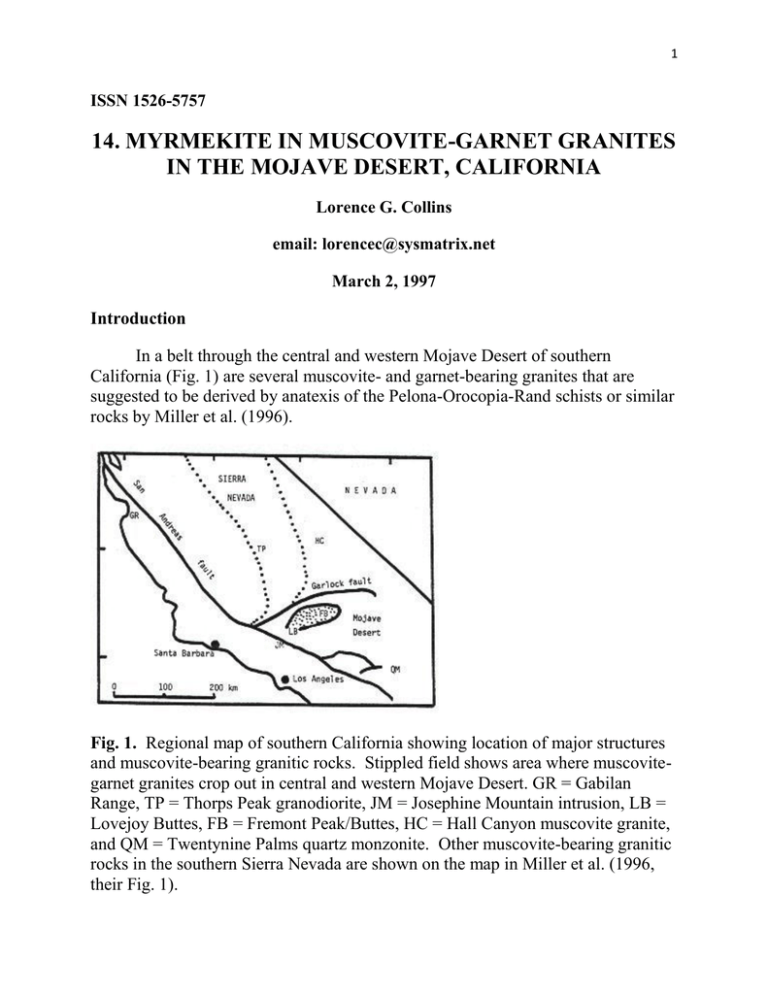
1 ISSN 1526-5757 14. MYRMEKITE IN MUSCOVITE-GARNET GRANITES IN THE MOJAVE DESERT, CALIFORNIA Lorence G. Collins email: lorencec@sysmatrix.net March 2, 1997 Introduction In a belt through the central and western Mojave Desert of southern California (Fig. 1) are several muscovite- and garnet-bearing granites that are suggested to be derived by anatexis of the Pelona-Orocopia-Rand schists or similar rocks by Miller et al. (1996). Fig. 1. Regional map of southern California showing location of major structures and muscovite-bearing granitic rocks. Stippled field shows area where muscovitegarnet granites crop out in central and western Mojave Desert. GR = Gabilan Range, TP = Thorps Peak granodiorite, JM = Josephine Mountain intrusion, LB = Lovejoy Buttes, FB = Fremont Peak/Buttes, HC = Hall Canyon muscovite granite, and QM = Twentynine Palms quartz monzonite. Other muscovite-bearing granitic rocks in the southern Sierra Nevada are shown on the map in Miller et al. (1996, their Fig. 1). 2 This belt is west of an interior belt of muscovite-bearing granitoids (Miller and Barton, 1990) and was examined by Miller et al. (1996) to see if granites in the Mojave Desert terrane could be correlated with other muscovite-bearing granites on the western side of the San Andreas Fault. One of these supposedly-related granites occurs in the Gabilan Range (Fig. 1, GR) and has been hypothesized to have moved northward along the fault relative to the Lovejoy Butte muscovite granite in the Mojave Desert (Fig. 1, LB). Miller et al. (1996) point out that if the granites on either side of the fault are related, then the timing of their emplacements as well as the timing of the penetration of the supposed schistsource rocks under the granites creates problems that need explanation. As a possible solution to this enigma, I suggested an alternative explanation in a "Comment" article (Collins, 1997), proposing that K- and Si-metasomatism of former deformed mafic igneous plutons could have produced these peraluminous granites and that such an origin removes the problems described by Miller et al. (1996). Moreover, a metasomatism hypothesis also opens the possibility that the granites on opposite sides of the San Andreas Fault may not be related. In the one page available for the "Comment" in the journal, however, I was unable to provide adequate evidence and justification for this hypothesis. Therefore, Miller et al. (1997) easily pointed out reasons why they considered it to be spurious. Among their criticisms are topics dealing with four major features: (1) deformation in the granitic plutons, (2) myrmekite, (3) metasomatism and movements of elements in fluids, and (4) modifications of isotopic systems. The purpose of this presentation is to examine the criticisms in all of these topics and provide evidence to support the metasomatism hypothesis. I will point out areas in which I agree or disagree with Miller et al. (1997). Perhaps the photomicrographs presented here will provide more information on the subject. Mafic rocks and deformation in the Mojave Desert plutonic rocks Three main points are made by Miller et al. (1997) regarding mafic rocks and deformation of the granitic rocks in the Mojave Desert terrane. 1. The field evidence in the Mojave Desert terrane does not support the model for K- and Si-metasomatism of massive mafic igneous rocks through zones of deformation. 2. "In the western Mojave there is one locality (Fremont Peak/Buttes area) where mafic and intermediate rocks are associated with muscovite-garnet granites. 3 There are virtually no other mafic rocks elsewhere in the western Mojave (Dibblee, 1967)." 3. "Deformation in the Fremont Peak/Buttes area was accompanied by metamorphism and magmatism (Miller et al., 1992; Glazner et al., 1994), and this locality exhibits classic igneous field relations. Pressures (P) and temperatures (T) accompanying deformation in this area were near the wet granite solidus (Henry and Dokka, 1992; Miller et al., 1992; Glazner et al., 1994). Are these the metasomatic P and T conditions that Collins envisions? We know of no other such deformation zones associated with these granites, nor were any mapped by Dibblee (1967)..." Belief that the granites are "the products of metasomatism of massive mafic igneous rocks through zones of deformation lacks any credible field evidence." I agree with Miller et al. (1997) that in most places, the field evidence does not support the model for K- and Si-metasomatism of massive mafic igneous rocks through zones of deformation. Most myrmekite-bearing granitic plutons in the Mojave Desert have a massive, outward, undeformed appearance. A welldeveloped foliation and/or S- and C-structures that are normally used as evidence of deformation do not exist. This lack of field evidence does NOT mean, however, that the granitic rocks have not been strongly deformed. In order to recognize this deformation, one must utilize thin-section evidence. For example, the megacrystal Twentynine Palms quartz monzonite in the southeastern part of the Mojave Desert (Fig. 1, QM) appears in the field to have an outward, undeformed appearance in which the megacrysts have a random orientation; See figure below. 4 Fig. 3 in http://www.csun.edu/~vcgeo005/Nr9Twenty.pdf. Megacrystal Twentynine Palms quartz monzonite in Bartlett Mountains northwest of Joshua Tree, California (Hopson, 1996), but also typical of megacrystal quartz monzonite plutons in Joshua Tree National Park. K-feldspar megacrysts are about 4 cm long. Yet, in thin section a megacryst in many places is seen to consist of undeformed K-feldspar that encloses remnant, angular, broken fragments of groundmass minerals. In some places inclusions of fine-grained broken crystals constitute more than 50% of the megacryst. 5 Fig. 11 in http://www.csun.edu/~vcgeo005/Nr9Twenty.pdf. Tiny portion of a microcline megacryst (dark gray), 2 to 3 cm long, in Twentynine Palms quartz monzonite. Megacryst contains more than 50 vol. % fragments of quartz and plagioclase (gray and white) and a few tiny euhedral sphene crystals (brown), all remnants of a cataclastically deformed diorite. Hornblende is absent and presumably replaced by quartz and/or microcline. In hand specimen, the megacryst looks like one of those shown in Figs. 3 and 4 (in http://www.csun.edu/~vcgeo005/Nr9Twenty.pdf) and gives no outward clue that it contains abundant inclusions. In most megacrysts, inclusions are less abundant (5 to 20 vol. %). Moreover, the formation of these K-feldspar megacrysts can be traced in a few places from their first appearance in undeformed felsic diorite (Fig. 4 in http://www.csun.edu/~vcgeo005/Nr9Twenty.pdf ) through progressive degrees of cataclasis. In the transition tiny K-feldspar crystals appear in the interiors of deformed plagioclase, increase in size (growing beyond the boundaries of the initial plagioclase crystal), and eventually surround the broken remnants of the adjacent groundmass minerals. Thus, these crystals grow to become megacrysts in the recrystallized quartz monzonite (the former felsic diorite). Myrmekite that is produced in the process serves as a clue to the process. The final product, when the process is repeated throughout vast volumes of deformed rock is a huge granitic body, several kilometers across. Significantly, most of this pluton lacks 6 any outward appearance of being a former cataclastically broken rock, yet thin sections of this rock show that it was once strongly deformed. I contend that most, if not all, other myrmekite-bearing quartz monzonite and granite masses in the Mojave Desert area in the belt (Fig. 1), studied by Miller et al. (1996), have the same deformation, replacement, and recrystallization characteristics that are unseen in the field by the unaided eye. For example, in these granitoids, plagioclase crystals are commonly deformed. Albite-twin lamellae may be bent, or the crystals are fractured and locally granulated (Figs. 2 and 3). Fig. 2. Albite-twinned plagioclase (tan, left side) with cataclastically broken border. Tiny fragments of the plagioclase are surrounded and replaced by microcline (black and gray, right side). 7 Fig. 3. Albite-twinned plagioclase (white, top) with cataclastically broken border. Veins of microcline (gray-black) penetrate the plagioclase along fractures (upper left). Remnants of the original plagioclase crystal extend in a stringer of broken grains from the main crystal through the microcline, and some of these grains have converted to myrmekite. A plagioclase inclusion (cream; lower left quadrant) in the microcline is bordered by myrmekite. Along the fractures microcline replaces the plagioclase and/or surrounds the fragments. Where replacement is incomplete, islands of plagioclase remain in the microcline in optical continuity with unreplaced adjacent plagioclase (Figs. 4, 5, and 6). 8 Fig. 4. Albite-twinned plagioclase (tan) with quartz inclusions (white) is replaced along fractures by microcline (black). Remnant islands of plagioclase remain in the microcline in parallel optic-continuity with the main, unreplaced plagioclase. Minor muscovite (blue) occurs in the plagioclase. Fig. 5. Albite-twinned plagioclase (white) occurs as remnant islands in microcline (gray). The plagioclase islands are in parallel optic-continuity. Minor muscovite (red, yellow, blue) occurs in the microcline. 9 Fig. 6. Albite-twinned plagioclase (cream) occurs as remnant islands in microcline (gray to black). The plagioclase islands are in parallel optic-continuity, and the microcline penetrates the plagioclase along fractures. Although the granitoids in the Mojave Desert terrane do not exhibit deformation features that are readily apparent in the field, this terrane has essentially been compressed in a vise during plate movements between the Sierra Nevada and the Southern California batholiths. Crushed rock fabrics, generated by this compression, have been recrystallized and replaced, as is evident in thin section. Movements along deep fault systems that cut through this area must have caused serious deformation and cataclasis of tonalites (or more mafic rocks) in and near the faults. How could this area not have been deformed? Because these fault systems likely shifted orientations and positions from time to time, many avenues were opened through which metasomatic fluids could move and modify the rocks. In that process, which is repeated over and over again, large volumes of K and Si were introduced to convert the tonalites to quartz monzonites and muscovite-garnet granites. I also agree with Miller et al. (1997) that in only one place (Fremont Peak/Buttes; Fig. 1, FB) is there any large mass of mafic plutonic rock in the Mojave Desert, and it is a massive biotite-hornblende-pyroxene diorite. It probably 10 was not replaced because hornblende- and pyroxene-rich rocks are not as easily deformed as are biotite-rich intermediate facies, such as biotite tonalites. On the north flank of Fremont Peak, a biotite-rich tonalite is strongly deformed. Here, interstitial K-feldspar and myrmekite appear in transition zones to quartz monzonite and granite, and the myrmekite has tiny quartz vermicules (Fig. 3). Plagioclase in this rock is deformed, broken, and replaced by microcline, like that shown in Fig. 4, Fig. 5, and Fig. 6. Biotite and cores of zoned plagioclase are commonly replaced by muscovite (Figs. 7 and 8). Thus, the deformed biotite tonalite (lacking muscovite) shows physical evidence of being converted to the muscovite-garnet bearing rocks. Fig. 7. Muscovite (blue, purple) in cores of plagioclase (black). Quartz is cream or tan. Rims of plagioclase are myrmekitic against microcline (gray). In other places (not shown), muscovite replacement of plagioclase is not as well developed, and the muscovite occurs as ragged tiny islands. 11 Fig. 8. Biotite (tan, dark brown) is replaced by tiny crystals of muscovite (white, pink, green). In other places (not shown) larger muscovite crystals extend through or around the biotite. Quartz is cream and white. Muscovite does not logically form by crystallization from a magma in the cores of plagioclase, but because the relatively calcic cores of plagioclase are proportionately Al-rich and because muscovite has a higher density than plagioclase and can include twice as much aluminum per unit volume in its structure than does K-feldspar, muscovite is a logical replacement mineral. Its higher density means that it does not need to make room for itself as K displaces Ca and Na from the deformed plagioclase and incorporates the released Al into the muscovite structure. It is apparent from these relationships that replacements have occurred in the deformed rocks, although the replacements are likely not all at constant volume. The aforesaid replacement characteristics are common in other remnant biotite tonalites throughout the western part of the granite belt (Fig. 1). Where these tonalite masses show increasing degrees of deformation (in thin section), muscovite, quartz, and microcline increasingly replace biotite and plagioclase. These replacements change the tonalites into either myrmekite-bearing quartz monzonite or muscovite-garnet granites, depending upon the degree of replacement. 12 Lastly, I agree that in many places the granitic rocks exhibit "classic igneous field relations," and they have pressure-temperature conditions near the "wet granite solidus." That is not at all unexpected. Where compositions of tonalite are converted to that of granite, and increase in temperature could easily cause partial or complete melting. Movements of these melts (solutions) could produce the "classic igneous field relations." On that basis, the question asked by Miller et al. (1997): "Are these the metasomatic P and T conditions that Collins envisions?" requires the obvious answer. When the granites were at temperatures above the solidus, existing as magma, metasomatism did not and cannot occur. But it does not necessarily follow from that answer that metasomatism did not affect these rocks at subsolidus temperatures prior to the melting or following crystallization of the magmas. In some areas of the Mojave Desert terrane, magmatism is undoubted. The muscovite-garnet granites exhibit primary zoned K-feldspar crystals with concentrically oriented plagioclase inclusions, and this K-feldspar coexists with normal-zoned, but relatively-sodic, plagioclase (Fig. 9). Nevertheless, these same rocks in some places show cataclastic textures and contain secondary, unzoned, sodic plagioclase and secondary, unzoned microcline, and the microcline is locally bordered by myrmekite with tiny quartz vermicules (Figs. 9 and 10). Fig. 9. Zoned plagioclase with myrmekite borders against microcline (gray, black) . 13 Fig. 10. Myrmekite with tiny, branched, quartz vermicules bordering microcline (gray). Quartz is cream, gray, and white. Albite-twinned plagioclase (white, top center) is myrmekitic against microcline (black, right side). These relationships occur in the muscovite-rich granite in the Lovejoy Buttes east of Palmdale, California (Fig. 1, LB). This muscovite granite is bounded on the northeast side by remnants of biotite-hornblende tonalite, and the muscovite granite adjacent to this tonalite contains biotite that could be remnants from the original tonalite (Fig. 11). On the basis of the tonalite association here and the coexistence of tonalite with granites in other places in the Mojave Desert, there is reasonable justification to suggest that former intermediate to mafic igneous rocks once occupied the volumes where muscovite-granite masses now occur. 14 Fig. 11. Myrmekite (black and white) with tiny quartz vermicules borders microcline (black) adjacent to plagioclase (light gray). Remnants of biotite (brown) occur in muscovite (red, yellow, green, blue, orange). Myrmekite in the plutonic rocks The three main points made by Miller et al. (1997) concerning myrmekite are: 1. Myrmekite in the western Mojave granites is "generally restricted to grain boundaries of K-feldspar and composes much less than 1% of any thin section." 2. "Importantly, myrmekite is no more common in the muscovite-garnet granites than in any of the more Ca-rich (lacking muscovite and garnet) monzonitic intrusions in the central and western Mojave Desert that we have studied (e.g., Miller and Glazner, 1995)." 3. "Because myrmekite is ubiquitous in plutonic rocks, it cannot be used to argue that the muscovite-garnet granites in the western Mojave are uniquely formed by metasomatism." 15 These statements indicate a lack of understanding of the occurrence of myrmekite and its consequence. Wartlike myrmekite normally borders K-feldspar and generally constitutes less than 1% of any thin section. Thus, the presentations of these facts have no significant meaning. The abundance of myrmekite is also not important, so their statement that myrmekite is "no more common in the muscovite-garnet granites than in any of the more Ca-rich (lacking muscovite and garnet) monzonitic intrusions in the central and western Mojave Desert" misses the point. Furthermore, large granitic bodies, which are truly magmatic and undeformed, occur in many other terranes, and these granites do not contain myrmekite. What is significant is the ubiquitous presence of myrmekite in the granites and quartz monzonites in the Mojave Desert terrane, reported by Miller et al. (1997), which gives a unique meaning. K- and Si-metasomatism likely generated the granitic rocks in this area. The general lack of biotite tonalites in the Mojave Desert terrane suggests the thoroughness of the metasomatism that modified these rocks. Myrmekite that occurs in the granitic rocks in the Mojave Desert has quartz vermicules whose maximum thickness corresponds to the Ca-content of the former primary plagioclase which the K-feldspar replaced (Collins, 1988; Hunt et al., 1992; see presentations 1 and 2 in this web site). In the Lovejoy Butte, where the granite likely replaced a biotite tonalite, the myrmekite has relatively tiny quartz vermicules (Fig. 11), which correlates to the relatively-sodic plagioclase in the tonalite. The correlation of vermicule size with plagioclase compositions in associated mafic wall rocks would not be expected if the granites were not related to the wall rocks. Furthermore, in some muscovite-bearing granitoids in the belt (Fig. 1), myrmekite contains coarser quartz vermicules (Fig. 12) than those in the Lovejoy Butte muscovite granite. This coarseness suggests that the tonalite that was replaced to produce the myrmekite-bearing granitoid contained relatively more-calcic plagioclase. 16 Fig. 12. Myrmekite with intermediate-sized quartz vermicules in a muscovitebearing biotite quartz monzonite Metasomatism and movements of elements in fluids Miller et al. (1997) suggested that my arguments "regarding element migration in fluids are circular," and that no physical or chemical basis for the metasomatism hypothesis were presented in my "Comment." That is, the chemical transformations in which mafic rocks lose K, Ca, Al, Mg, and Fe by breakdown of ferromagnesian silicates and plagioclase and the processes in which fluids add Si, K, Na, and Al to other rocks were not addressed with balanced reactions. Moreover, they pointed out that volume-composition relations that accomplish these changes were not specified. The absence of balanced reactions for volumecomposition relationships in the "Comment" was then utilized by Miller et al. (1997) as an easy target, saying that without these equations the metasomatism hypothesis for the origin of granites is unconvincing. However, even if space had been available to write such equations, it is likely from their other criticisms that such efforts would have been useless. Arguments for element migration in fluids are not circular, because the aforesaid thin-section evidence for cataclasis and replacement indicates that elements must have moved in and out of the deformed rocks. Admittedly, the chemical basis (the nature of the fluids) that caused the transformation is not 17 understood, but the chemical means of moving the elements are processes that experimentalists need to help solve. Modifications of the isotopic systems Four comments were made by Miller et al. (1997) regarding the metasomatic model for modifications of the isotopic systems. 1. Points, suggesting that elevated initial 87Sr/86Sr ratios in muscovite-garnet granites and scatter in initial ratios are due to metasomatism, "seem to be selfdefeating and nonsensical." 2. If fluids come from some deeper levels of the crust and carry radiogenic Sr upward, where presumably it is concentrated in new minerals formed by metasomatism, and "if the granites were once mafic intrusions that have undergone this metasomatic transformation, then they too should have lost their radiogenic Sr if this hypothesis is correct." The same arguments can be applied to the Nd isotopic system. 3. The western Mojave granites "do not have elevated 87Sr/86Sr ratios (or low epsilon-Ndt values) when compared with muscovite-garnet granites of the Cordilleran interior, like the Hall Canyon pluton (Mahood, et al., 1996)." 4. The scatter in the isotopic data does not support a metasomatic model and is better supported by a magmatic origin for the granites. It is well known that rocks which are deformed and subjected to penetration by hydrous fluids have their isotopic systems disrupted. These systems would include Rb-Sr, Nd-Sm, and oxygen isotopes. In my "Comment," I proposed that the scattering of Rb-Sr data, reported by Miller et al. (1996), made it impossible for them to plot isochrons. I then suggested the following as a possible explanation for the isotopic variability. "Strontium released from biotite replaced by quartz at depth has high Sr/ Sr ratios due to the radioactive decay of 87Rb, which is high in biotite, and moves upward into the deformed mafic intrusions that become the muscovite granites. The concentration of this displaced strontium elevates the initial 87Sr/86Sr ratios for these rocks to values as high as 0.711 (data from Miller et al., 1996, Table A). The replacement of biotite and other ferromagnesian silicates by quartz would also cause the delta 18O values to rise because introduced Si ions with +4 charge and small ionic size tend to retain 18O more readily than 16O. Moreover, the 87 86 18 Nd-Sm systematics are also affected, enriching the granitic rocks in 143Nd and producing negative epsilon-Ndt values (Collins, 1988). These trends of elevated initial muscovite-bearing granitic rocks that also contain myrmekite, including the Pedrobernardo granite in Spain (Bea et al., 1994; personal communication, 1996), the zoned plutons in Scotland (Stephens and Halliday, 1979), the Hall Canyon pluton in the White-Inyo Range of eastern California (Mahood et al., 1996), and the leucogranite sills and laccoliths of the high Himalayas of India (Dietrich and Gansser, 1981). The aberrant isotopic data along with the presence of myrmekite suggest that K- and Si-metasomatism have occurred in the belt of muscovite-garnet granitic rocks in the western Mojave Desert as well as in the other muscovite granites for which Miller and others (1996) made isotopic comparisons. These myrmekitebearing granites include the Josephine Mountain granite (Barth et al., 1995; worldwide web site: http://www.csun.edu/~vcgeo005), the southern Sierra Nevada batholith in the southwestern Tehachapi Mountains (Ross, 1989), the Gabilan Range in the eastern side of Salina (Ross, 1972), and the Tharps Peak granodiorite in the western part of central Sierra Nevada (Liggett, 1990; personal communication, 1996)." On the basis of the arguments and evidence provided in the aforesaid sections, I still stand by the above statements about the isotopic systematics. I agree with Miller et al. (1997) that "if the granites were once mafic intrusions that have undergone this metasomatic transformation, then they too should have lost their radiogenic Sr if this hypothesis is correct." I propose that the rocks converting to granites, while losing some radiogenic Sr, are enriched in Rb because the Rb also accompanies K. This K and Rb replace the plagioclase to form K-feldspar or muscovite. The loss of both radiogenic and common Sr from the recrystallized and replaced primary plagioclase reduces the total strontium (including 86Sr)in the residual recrystallized rock. In this way the amount of 87Rb is proportionately increased in the residual rock relative to the residual radiogenic Sr. The greater abundance of 87Rb (that decays to form 87Sr) relative to the lesser abundance of residual total Sr resets the initial ratios to higher values. Moreover, because the granites are relatively high in the crust, they may still gain Sr with high 87 Sr/86Sr ratios from fluids that carry this material up from biotite at depth which breaks down in early replacement processes. Miller et al. (1997) suggest that the "western Mojave granites do not have elevated 87Sr/86Sr ratios (or low epsilon-Ndt values) when compared with 19 muscovite-garnet granites of the Cordilleran interior, like the Hall Canyon pluton (Mahood, et al., 1996)." The Hall Canyon pluton has an initial 87Sr/86Sr ratio of 0.719 in comparison to the values which range from 0.706 to 0.711 for the granitic rocks in the Mojave Desert terrane, and, therefore, the statement by Miller et al. (1997) seems quite reasonable. But the Hall Canyon pluton is a poor choice for Miller et al. (1997) to use in support of the magmatic model because this pluton is strongly deformed, myrmekite-bearing, and likely is another example of a magmatic rock modified by metasomatism. See http://www.csun.edu/~vcgeo005/Nr15Hall.pdf. The metasomatism in the Hall Canyon pluton provides good reason for it also to have a high 87Sr/86Sr initial ratio. Conclusion On the basis of (1) the ubiquitous presence of myrmekite in the granitic rocks in the Mojave Desert terrane, (2) the thin-section evidence for cataclasis of plagioclase in former tonalites that have been converted to quartz monzonites and muscovite-garnet granites, (3) the general lack of tonalites in this area, and (4) the nearly continuous deformation of this area from the Mesozoic era to the present, the rocks here likely have been subjected to introduction of metasomatic fluids in repeated episodes. The thoroughness and extend to replacement means that few tonalites remain. Granite magmatism has certainly occurred in this terrane, but metasomatism likely occurred before and following the magmatism. References Barth, A. P., Wooden, J. L., Tosdal, R. M., and Morrison, J., 1995, Crustal contamination in the petrogenesis of a calc-alkalic rock series: Josephine Mountain intrusion, California: Geological Society of America Bulletin, v. 107, p. 201-212. Bea, F., Pereira, M. D., Corretge, L. G., and Fershtater, G. B., 1994, Differentiation of strongly peraluminous, perphosphorous granites: The Pedrobernardo pluton, central Spain: Geochimica et Cosmochimica Acta, v. 58, p. 26092627. Collins, L. G., 1988, Hydrothermal Differentiation And Myrmekite - A Clue To Many Geological Puzzles: Athens, Theophrastus Publications, 387 p. Collins, L. G., 1997, Muscovite-garnet granites in the Mojave Desert: Relation to crustal structure of the Cretaceous arc: Comment: Geology, v. 25, p. 187. Dibblee, T. W., Jr., 1967, Areal geology of the western Mojave Desert, California: U. S. Geological Survey Professional Paper 522, 153 p. 20 Dietrich, V., and Gansser, A., 1981, The leucogranites of the Bhutan Himalaya (crustal anatexis versus mantle melting): Schweischerische mineralogische und petrographische Mitteilungen, v. 61, p. 177-202. Dipple, G. M., and Ferry, J. M., 1992, Metasomatism and fluid flow in ductile fault zones: Contributions to Mineralogy and Petrology, v. 112, p. 149-164. Glazner, A. F., and nine others, 1994, Reconstruction of the Mojave Block: Geological Society of America Cordilleran Section Guide Book, Field Trip 1, p. 3-30. Henry, D. J., and Dokka, R. K., 1992, Metamorphic evolution of exhumed middle to lower crustal rocks in the Mojave extensional belt, southern California, USA: Journal of Metamorphic Geology, v. 10, p. 347-364. Hunt, C. W., Collins, L. G., and Skobelin, E. A., 1992, Expanding Geospheres, Energy And Mass Transfers From Earth's Interior: Calgary, Polar Publishing Co., 421 p. Order from: http://www.polarpublishing.com Liggett, D. L., 1990, Geochemistry of the garnet-bearing Tharps Peak granodiorite and its relation to other members of the Lake Kaweah intrusive suite, southwestern Sierra Nevada, California, in Anderson, J. L., ed., The nature and origin of Cordilleran magmatism: Geological Society of America Memoir 174, p. 225-236. Mahood, G. A., Nibler, G. E., and Halliday, A. N., 1996, Zoning patterns and petrologic processes in peraluminous magma chambers: Hall Canyon pluton, Panamint Mountains, California: Geological Society of America Bulletin, v. 108, p. 437-453. Miller, C. F., and Barton, M. D., 1990, Phanerozoic plutonism in the Cordilleran interior, U.S.A.: Geological Society of America Special Paper 241, p. 213231. Miller, J. S., and Glazner, A. F., 1995, Jurassic plutonism and crustal evolution in the central Mojave Desert, California: Contributions to Mineralogy and Petrology, v. 118, p. 437-453. Miller, J. S., Glazner, A. F., and Crowe, D. E., 1996, Muscovite-garnet granites in he Mojave Desert: Relation to crustal structure of the Cretaceous arc: Geology, v. 24, p. 335-338. Miller, J. S., Glazner, A. F., and Crowe, D. E., 1997, Muscovite-garnet granites in the Mojave Desert: Relation to crustal structure of the Cretaceous arc: Comment: Geology, v. 25, p. 188. Miller, J. S., Fletcher, J. M., Boettcher, S. S., Martin, M. W., and Glazner, A. F., 1992, Late Cretaceous deformation, plutonism, and cooling around Fremont Peak, central Mojave Desert, California: EOS (Transactions, American Geophysical Union), v. 73, p. 574. 21 Ross, D. C., 1972, Petrographic and chemical reconnaissance study of some granitic and gneissic rocks near the San Andreas fault from Bodega Head to Cajon Pass, California: U. S. Geological Survey Professional Paper 698, 92 p. Ross, D. C., 1989, The metamorphic and plutonic rocks of the southernmost Sierra Nevada, California, and their tectonic framework: U. S. Geological Survey Professional Paper 1381, 159 p. Stephens, W. E., and Halliday, A. N., 1979, Compositional variations in the Galloway plutons; in Atherton, M. P., and Tarney, J., eds., Origin of granite batholiths, geochemical evidence: United Kingdom, Shivra Publishing Limited, p. 9-17.
